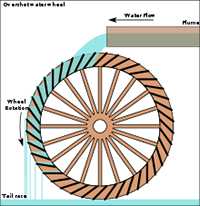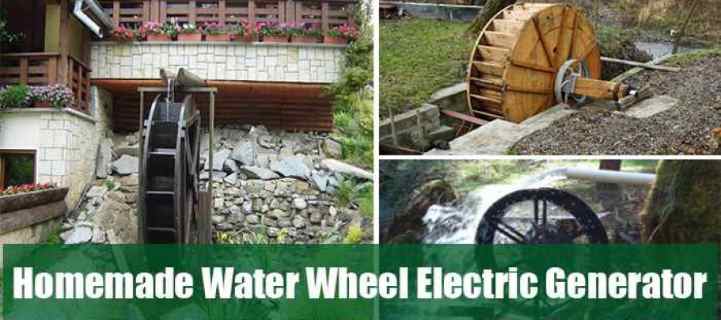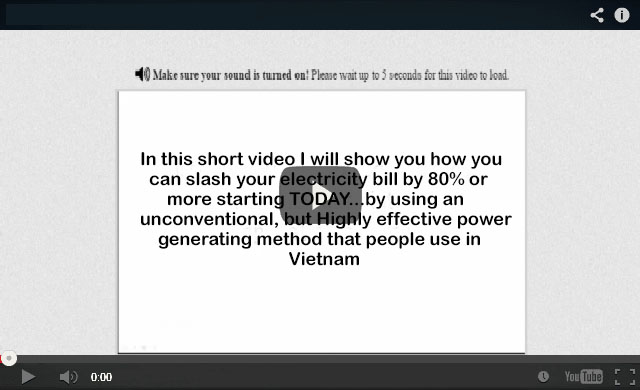Homemade Water Wheel Electric Generator
A medium size water wheel electric generator can provide enough electricity for one house (3 bulbs, one TV and one radio all running at the same time). Not only you will no longer dependent on the power grid, but you’ll have electricity when SHTF and more important: absolutely FREE. Unlike solar panels, a water wheel electric generator can produce electricity 24/7.
Hydroelectricity is the world’s largest and cleanest source of renewable energy. But despite lively interest in renewables generally, there is an information vacuum about the smallest version of the technology dubbed “the simplest, most reliable and least expensive way to generate power off grid.”
Hydroelectric energy has been used worldwide for a long time to generate huge amounts of electricity from water stored behind massive dams. Small scale hydropower generators are usually used without a damn. They are called run-of-the-river micro-hydro installations and they are very efficient. For example a small water wheel electric generator with a drop of only 3 ft may generate enough electricity for a small house. In the United States, run-of-the-river hydropower could potentially provide 60,000 MW (about 13.7% of total use if continuously available).
So, if you have a river or a brook nearby you may consider building a water wheel electric generator to power your home.
How The Water Wheel Electric Generator Works
 It’s actually pretty simple. The flowing, dropping water is spinning a wheel (see image). The wheel shaft it’s connected to a simple coil generator that produces electricity. You’ve probably seen that front bike flashlight is connected by a dynamo to the bike’s wheel. And while you are pedaling the flashlight is on. This is exactly the same principle.
It’s actually pretty simple. The flowing, dropping water is spinning a wheel (see image). The wheel shaft it’s connected to a simple coil generator that produces electricity. You’ve probably seen that front bike flashlight is connected by a dynamo to the bike’s wheel. And while you are pedaling the flashlight is on. This is exactly the same principle.
Usually, for a water wheel electric generator you need at least 3 feet of fall and at least 20 gallons per minute of flow. The more fall and flow you have, the more potential power you can generate. You can measure flow by building a weir in the creek and measuring how fast it will fill up a 5 gallon bucket.
Power Output in kilowatts-hour is calculated by the formula: KW = 0.004 x Q x V x H x C where:
Q = Weight of water (volume per sec x capacity of the buckets)
V = Velocity of the stream per second (meters)
H = Head, or height difference of water between the lip of the flume (head race) and the tailrace – meters
C = Efficiency Constant – usually around 50%
This is how you can actually calculate the energy your water wheel electric generator will produce.
Take a look at your monthly electric bill and see how many KW your household consumes per month. Divide the KW by the number of days the month had and again by 24. The result is the KW you consume per hour. Compare it with your formula results and see if the water wheel electric generator can produce enough electricity for your house or just a percent.
When civilization collapses, he predicts, the world will go back to barter. Urges everyone to have a disaster-preparedness kit containing enough food, water and other supplies to last 72 hours. This is sensible advice, and prepares have a point when they mock those who ignore it.
How To Build a Small Water Wheel Electric Generator
Mainly a water wheel electric generator has two major components: the wheels and the dynamo. These components can be made both at home, but I recommend buying the dynamo because it’s not easy to make a very efficient one.
The largest wheel is the one which holds the water and the first to spin. When building the wheel you have to take into consideration the scale and the materials. For the overshot wheel the optimal diameter of the wheel is the largest possible (the drop) and the optimal rotational speed of is approximately: 21/ √D where D is the diameter of the wheel (meters).
You can build it from any material but the lighter, the better. Most water wheels are built from wood.
First we have to build the wooden wheels. You can do it by using the top and bottom of the barrel or you can build it from scratch. Here is a video tutorial (3 parts):
In order to produce more electric power you have to connect the wooden wheel to a smaller wheel thru a chain or by using a cogwheel in order to generate more rotations even if you lose some physical power over the rotation. Usually a dynamo doesn’t need much force to work optimal but rather a high rotation speed.
If you don’t want to use a dynamo to generate electricity you can use an electric DC motor. Most DC motors can operate as generators.
This video will better explain how to interconnect the wheels and maximize the output:
The pipe has to be as large as possible to minimize the friction and maximize the flow. The higher the drop and the larger the flow the more electricity your water wheel generator will produce. You may also take into consideration a capacity to store electricity and use it when in need. For example a solar energy storage battery will work just fine.
If you don’t need electricity you may adapt the water wheel to grind grain, to cut wood, strengthen iron or to sharpen tools. Anyway you choose to use it, a water wheel is an important installation when living off the grid or when SHTF.
If you still find it complicated building a water wheel electric generator by yourself, you may use a step by step guide with more specific measurements.
Another very efficient use of a water wheel electric generator is for aquaponic systems. If you already have an aquaponic system think about maximizing the outcome by producing free electricity to light a neon bulb (for example) to help plants grow even faster. Usually the water is pumped from the fish tank up to the plants. Where water is directed back to the fish tanks place a mini water wheel generator. If you are interested in building an aquaponic system you might find this video very helpful.
Other useful resources:
Survival MD (Best Post Collapse First Aid Survival Guide Ever)
Backyard Innovator (A Self Sustaining Source Of Fresh Meat,Vegetables And Clean Drinking Water)
Blackout USA (EMP survival and preparedness)
Conquering the coming collapse (Financial advice and preparedness )
Liberty Generator (Build and make your own energy source)
Backyard Liberty (Easy and cheap DIY Aquaponic system to grow your organic and living food bank)
Bullet Proof Home (A Prepper’s Guide in Safeguarding a Home )
Family Self Defense (Best Self Defense Strategies For You And Your Family)
Sold Out After Crisis (Best 37 Items To Hoard For A Long Term Crisis)
SOURCE : www.askaprepper.com



